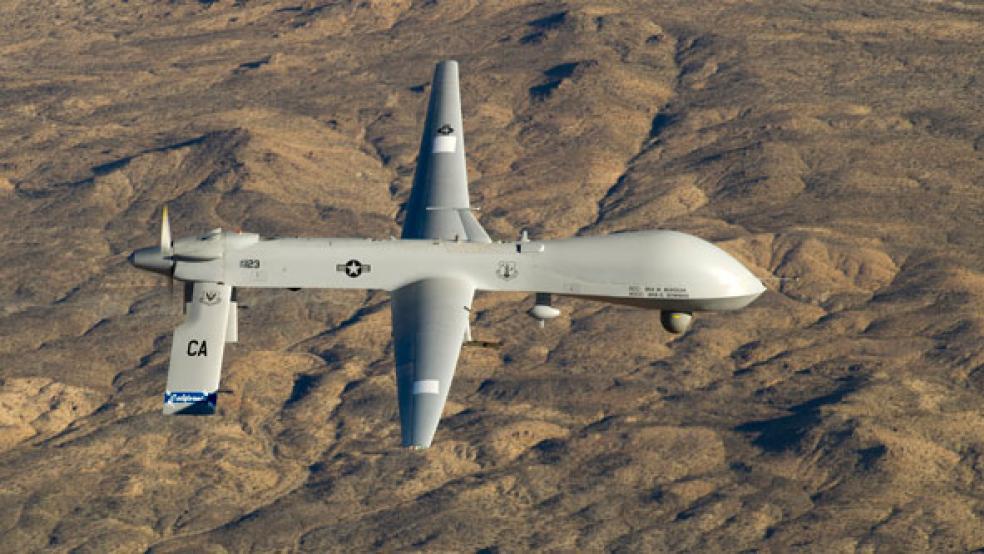As John Brennan prepares to face a Senate committee as part of his nomination for Director of the CIA today, the use of drones, and their effectiveness, has become a distracting flashpoint for the Obama administration.

The controversy erupted this week when the Obama administration’s policy to target terrorists, including Americans citizens, was leaked. The policy allows suspected terrorists to be killed even if they have no immediate plans to attack American interests. According to the leaked Justice Department memo, the White House has this power because “[t]he threat posed by [al Qaeda] and its associated forces demands a broader concept of imminence in judging when a person continually planning terror attacks presents an imminent threat.”
After the document leaked, reports emerged that the CIA was operating a drone base out of Saudi Arabia. The left exploded with charges that Obama was violating civil liberties and due process. Some in Congress have now called for limits on presidential authority to use drones. Steny Hoyer, of Maryland, the second ranking Democrat in the House, told the AP that the policy “deserves a serious look at how we make the decisions in government to take out, kill, eliminate, whatever word you want to use, not just American citizens but other citizens as well.” They are likely to be a hot topic at Brennan’s hearing today.
Yet even as the controversy over drones grows, there is no doubt their use will continue. House speaker John Boehner announced his support of the administration’s drone policy. The administration has agreed to provide Congress with the legal justification for their drone policy, but in the past has showed no signs of backing down on issues related to national security.
Ground forces dispatched to fight terrorists instead of nations makes little sense compared with sending in special-forces, drones or robots.
Importantly, drones are a precursor to 21st century war and national security. The use of massive ground forces dispatched to fight terrorists instead of nations makes little sense compared with sending in special-forces, drones or robots. Still, as controversy over their use erupts, questions about drones have entered the mainstream. Are they cost effective, and do they achieve military objectives?
The United States has drones flying over Yemen, Afghanistan, Somalia and Pakistan, as well as places unknown. They have been used to kill terrorists: Abu Saleh al Masri, a powerful al Qaeda leader, was killed by a drone strike in Pakistan last year. They have also been used as part of broader international missions: a U.S. drone attacked Muammar Gadaffi’s convoy just before the former Libyan leader was captured and killed.
Drones have been used to kill American citizens. Anwar al-Awlaki, an American citizen who was a member of al Qaeda, was killed in a drone attack in Yemen in 2011.
Drones provide the obvious advantage of not putting American lives at risk. But of similar importance given the coming drawdown, drones give the Pentagon a low-cost way to eliminate known targets.
The cost of one MQ-9 Reaper drone is $6.4 million, according to an analysis by the American Security Project. The cost of one A-10 Thunderbolt, the plane with capabilities similar to the Reaper, is $18.2 million, adjusted for inflation. Maintenance costs for drones are also lower, as they require less mechanical expertise to fix.
Drones are also substantially cheaper than traditional ground forces. Under Secretary of Defense Robert Hale told Congress last year that each American troop in Afghanistan cost $850,000 per year. Using Hale’s conservative estimate, the 60,000 American troops in Afghanistan cost the Pentagon $51 billion last year. Over the next decade, the Pentagon only plans to spend $40 billion on unclassified drones.
But drones have severe limitations. The Obama administration has received multiple warnings about depending too heavily on its drone program, according to Bob Woodward’s book “Obama’s Wars.” Former CIA director Michael Hayden warned the president’s first chief of staff, Rahm Emanuel, that fighting Pakistani terrorists with Predator drone strikes wouldn’t resolve the threat against the United States. “Unless you’re prepared to do this forever, you have to change the facts on the ground,” the book quotes Hayden as saying.
Drone strikes against U.S. enemies were akin to attacking a beehive one bee at a time.
Similarly, Bruce Riedel--the former CIA officer who oversaw the administration’s first review of its Afghanistan and Pakistan policies—told Obama that the drone strikes only worked because of a network of human spies who identified targets. The metaphor reported in the book was that drone strikes against U.S. enemies were akin to attacking a beehive one bee at a time.
There are also concerns about where drones can be used. Right now, countries give the United States permission to operate drones in their airspace. If an enemy were in an uncooperative country – say Russia, for instance – it would be impossible to target using drones without provoking the rival. They are also relatively easy to shoot down, as Iran claimed to have done when a U.S. drone allegedly entered their airspace last December.
Lastly, there are unresolved moral concerns about drone use. They change the nature of war, making it easy to kill targets in an impersonal way. According to Jacob Stokes, a research associate at the Center for New American Security, drones are altering the way decision about killing enemies are made.
“If you know where a high-ranking terrorist leader is and he’s planning an attack, it makes sense to use a drone stroke to kill them,” he said. “But in a sense, it’s too easy. The process in which you decide to use a drone to kill someone might not be as vigorous as you hope it would be.”





